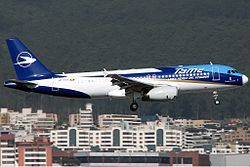Early years
The military airline was founded on December 17, 1962, by Luis A. Ortega under Guillermo Freile Posso, both colonels. It was named Transportes Aéreos Militares Ecuatorianos (TAME). At the time, the Air Force required an income source; governmental transport services to remote and difficult to reach parts of Ecuador; and an entity to train pilots. The airline gradually increased in size infrastructure and number of services.
On December 4, 1962, Luis A. Ortega, Hector Granja, Eduardo Sandoval, Alfredo Barreiro, Oswaldo Lara, Julio Espinosa, Teodoro Malo and Jose Montesinos made inaugural flights in the Douglas C-47. The pilots held the rank of major and noncommissioned officers worked as flight attendants. The first commercial flight was made by Teodoro Malo on a route from Quito, Esmeraldas, Bahía, Manta, Guayaquil, Cuenca and back to Quito. Initially, TAME made domestic flights using C-47 planes. Gradually, over the next two years, DC-3 and DC-6 planes were added and then in 1970, two HS-748 Avro were acquired.
On April 30, 1966, TAME began regular international flights to Havana, Panama and Santiago de Chile.
As its business grew, TAME purchased four Lockheed L-188 Electras from Ecuatoriana de Aviación. In the late 1970s and early 1980s, TAME added three Boeing 727-100s. During the mid-1980s and up until 1992, Tame purchased four Boeing 727-200s. In 1986, three Fokker F28 Fellowship 4000s were added. In December 1998, TAME rented a Boeing 757-200.
In December 1992, the governments of Ecuador and Colombia signed the "Frontier Integration Agreement" establishing a Quito, Esmeraldas (Tachina), Cali, Esmeraldas (Tachina), Quito route. In 1995, TAME offered flights from Quito to Bogotá for Air France passengers.
Development during the 2000s
In 2000, TAME began a long process of fleet renewal beginning with the renting of two Airbus A320s. These planes were delivered at the European Corporation Assemble factory, Toulouse and were renewed in 2008. Also in 2000, the Boeing 727s were retired. TAME found the Embraer 170/190s suited the airline's needs. Over the next two years, two models of the 170 series and one of the 190 series were obtained. On August 25, 2008, one Airbus A319 was obtained and soon after the two Airbus A320s were replaced, completing the fleet renewal.
In 2011, Tame changed its legal status to a state-owned company, no longer under the administration of the Ecuadorian Air Force.
In 2013, TAME incorporated its first and only Airbus A330-200, formerly of Dubai’s Emirates, to cover flights to New York City. In addition, 3 Quest Kodiaks were incorporated for its subsidiary TAME Amazonía for the routes in the country's Amazon.
On May 19, 2020, the Ecuadorean government decided to liquidate the airline and ceased all operations. The airline, which had been struggling for several years, claimed that its difficulties were compounded by the impact of the COVID-19 pandemic.




